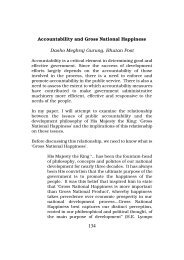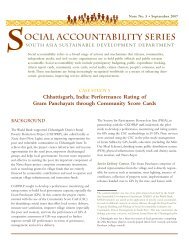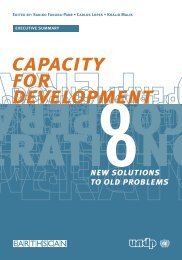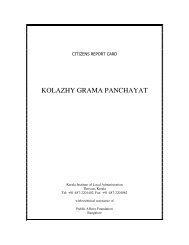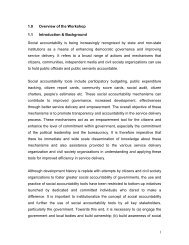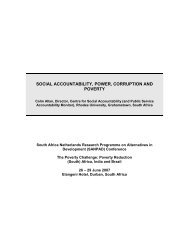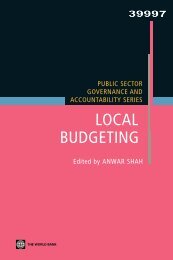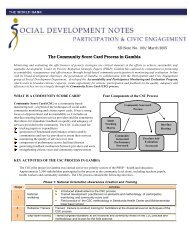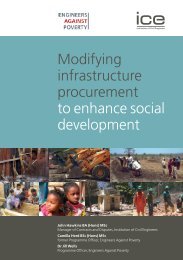Enabling Environment for Social Accountability in ... - SASANet
Enabling Environment for Social Accountability in ... - SASANet
Enabling Environment for Social Accountability in ... - SASANet
You also want an ePaper? Increase the reach of your titles
YUMPU automatically turns print PDFs into web optimized ePapers that Google loves.
khural chairs who served on the ORM board gradually withdrew from the organization, and were<br />
subsequently replaced at the annual ORM meet<strong>in</strong>g that followed, thus free<strong>in</strong>g up the organization to press<br />
its demands <strong>for</strong> government action to protect the Ongi River system from further decl<strong>in</strong>e. Curiously, the<br />
governors of Dundgovi and Umnugovi aimags, who also belong to the MPRP, ma<strong>in</strong>ta<strong>in</strong>ed their support<br />
<strong>for</strong> the organization. They may have realized the political implications of oppos<strong>in</strong>g such a groundswell of<br />
support from among their local constituencies. Moreover, the ORM had, by this time, established a<br />
rapport with highly placed MPRP leadership <strong>in</strong> UB.<br />
THE IMPORTANCE OF CSO ACCESS TO AND PROVISION OF INFORMATION<br />
Although there are other environmental factors, such as desertification and overgraz<strong>in</strong>g, m<strong>in</strong><strong>in</strong>g practices<br />
<strong>in</strong> Mongolia have had devastat<strong>in</strong>g environmental implications. In 2002, the leadership of ORM<br />
successfully lobbied the M<strong>in</strong>istry of Nature and the <strong>Environment</strong> to <strong>in</strong>vestigate the causes of<br />
environmental problems <strong>in</strong> the Ongi River Bas<strong>in</strong>. The study determ<strong>in</strong>ed that m<strong>in</strong><strong>in</strong>g had caused<br />
environmental damage <strong>in</strong> the bas<strong>in</strong> (F<strong>in</strong>d<strong>in</strong>g ORM 3). Heavy m<strong>in</strong><strong>in</strong>g had diverted the Ongi waters from<br />
their natural course, and the lack of effective restoration measures had impacted the dry<strong>in</strong>g up of the river.<br />
Furthermore, the study revealed that 28 rivers <strong>in</strong> the 8 aimags were <strong>in</strong> danger of dry<strong>in</strong>g up (Ongi 2004:3).<br />
Although the GoM study was critical to the ORM mission, the movement sought <strong>in</strong> 2002 to ga<strong>in</strong> further<br />
<strong>in</strong>dependent <strong>in</strong><strong>for</strong>mation about the current condition of the river system (F<strong>in</strong>d<strong>in</strong>g ORM 4). A study<br />
conducted by ORM’s consultant at Mongolia State University concluded that as a result of the seven<br />
ponds built along the Ult River by m<strong>in</strong><strong>in</strong>g companies, the river could no longer flow <strong>in</strong>to the Buruljut<br />
River, one of the tributaries of the Ongi River. He also found 10 other examples of m<strong>in</strong><strong>in</strong>g activities that<br />
had diverted rivers flow<strong>in</strong>g <strong>in</strong>to the Ongi. Although there has been no <strong>for</strong>mal response to these f<strong>in</strong>d<strong>in</strong>gs,<br />
which were presented to key parliamentarians and the Deputy M<strong>in</strong>ister of Nature and the <strong>Environment</strong>,<br />
the study provides further documentation of m<strong>in</strong><strong>in</strong>g company practices that adversely affect the<br />
environment.<br />
In Mongolia, 625 m<strong>in</strong><strong>in</strong>g companies are registered to explore and m<strong>in</strong>e m<strong>in</strong>eral resources, Among the 307<br />
that m<strong>in</strong>e gold, 32 m<strong>in</strong><strong>in</strong>g companies are licensed to operate <strong>in</strong> the Ongi River bas<strong>in</strong>. Together, they use<br />
20 percent of the region’s water resources (World Water Actions, 2004). The ma<strong>in</strong> environmental issues<br />
surround<strong>in</strong>g m<strong>in</strong><strong>in</strong>g <strong>in</strong> Mongolia are 1) no regulation of water use <strong>in</strong> the establishment of gold m<strong>in</strong>es; 2)<br />
use of antiquated technology by gold m<strong>in</strong><strong>in</strong>g companies that <strong>in</strong>volves creat<strong>in</strong>g dams and ponds; 3) weak<br />
monitor<strong>in</strong>g and en<strong>for</strong>cement of environmental laws, notably provisions on diversion of rivers,<br />
requirements <strong>for</strong> rehabilitation measures after m<strong>in</strong><strong>in</strong>g, and sanctions <strong>for</strong> noncompliance by m<strong>in</strong><strong>in</strong>g<br />
companies; and 4) m<strong>in</strong><strong>in</strong>g practices that attract artisanal “N<strong>in</strong>ja” m<strong>in</strong>ers along the rivers, whose activities<br />
are unregulated and there<strong>for</strong>e difficult to control by local government authorities.<br />
“N<strong>in</strong>jas” wear metal gear that earned them their name from the popular N<strong>in</strong>ja cartoon characters. They<br />
dig ponds and deep shafts to divert river water and then use mercury to filter the gold, pollut<strong>in</strong>g the land<br />
and water. Some public officials claim that the N<strong>in</strong>jas alone are to blame <strong>for</strong> current environmental<br />
problems. The chair of an aimag khural remarked that m<strong>in</strong><strong>in</strong>g companies rehabilitate the land after<br />
extraction, but N<strong>in</strong>jas dig up this land look<strong>in</strong>g <strong>for</strong> remnants of gold deposits. Aimag authorities, however,<br />
may be complicit. For example, <strong>in</strong> Arvakheer they allegedly permitted, perhaps even encouraged, the<br />
N<strong>in</strong>jas to dig up shafts that a m<strong>in</strong><strong>in</strong>g company had filled <strong>in</strong> as part of a restoration project. Aimag<br />
authorities ma<strong>in</strong>ta<strong>in</strong>ed that the N<strong>in</strong>jas also have rights to m<strong>in</strong>e and that this was “a complicated human<br />
rights issue.” As a remedy, Ongi representatives recommended that regardless of whether the companies<br />
or N<strong>in</strong>jas were responsible, soum governors should be authorized to stop companies from operat<strong>in</strong>g the<br />
follow<strong>in</strong>g season if they fail to rehabilitate a m<strong>in</strong><strong>in</strong>g area.<br />
77




